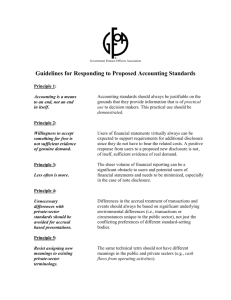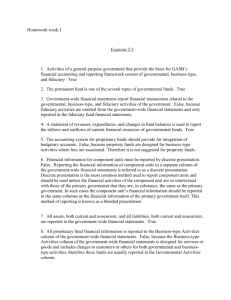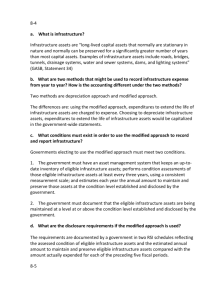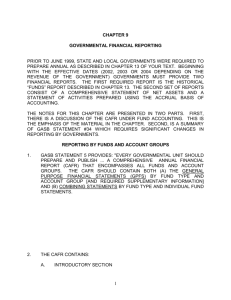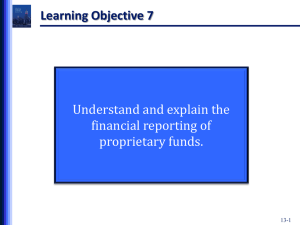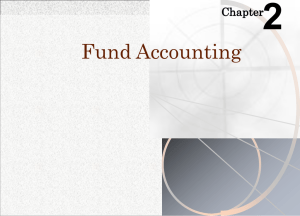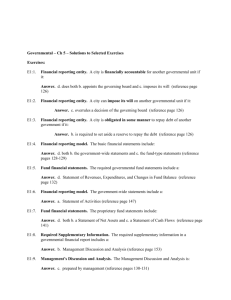Governmental Ch 5 Questions Solutions:
advertisement
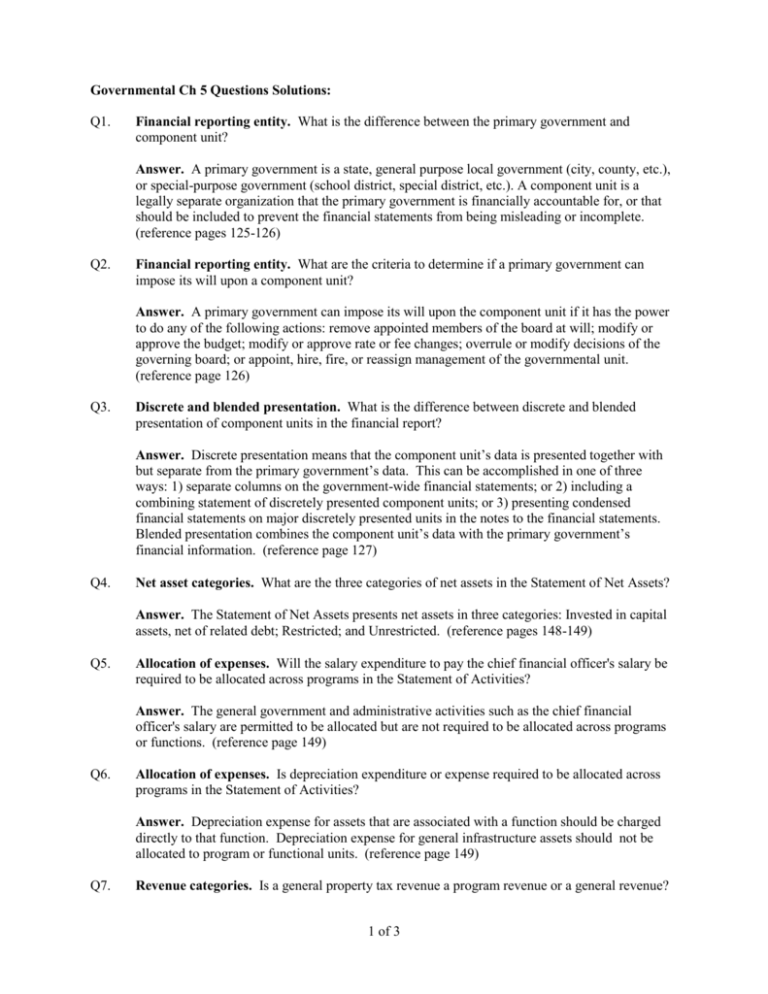
Governmental Ch 5 Questions Solutions: Q1. Financial reporting entity. What is the difference between the primary government and component unit? Answer. A primary government is a state, general purpose local government (city, county, etc.), or special-purpose government (school district, special district, etc.). A component unit is a legally separate organization that the primary government is financially accountable for, or that should be included to prevent the financial statements from being misleading or incomplete. (reference pages 125-126) Q2. Financial reporting entity. What are the criteria to determine if a primary government can impose its will upon a component unit? Answer. A primary government can impose its will upon the component unit if it has the power to do any of the following actions: remove appointed members of the board at will; modify or approve the budget; modify or approve rate or fee changes; overrule or modify decisions of the governing board; or appoint, hire, fire, or reassign management of the governmental unit. (reference page 126) Q3. Discrete and blended presentation. What is the difference between discrete and blended presentation of component units in the financial report? Answer. Discrete presentation means that the component unit’s data is presented together with but separate from the primary government’s data. This can be accomplished in one of three ways: 1) separate columns on the government-wide financial statements; or 2) including a combining statement of discretely presented component units; or 3) presenting condensed financial statements on major discretely presented units in the notes to the financial statements. Blended presentation combines the component unit’s data with the primary government’s financial information. (reference page 127) Q4. Net asset categories. What are the three categories of net assets in the Statement of Net Assets? Answer. The Statement of Net Assets presents net assets in three categories: Invested in capital assets, net of related debt; Restricted; and Unrestricted. (reference pages 148-149) Q5. Allocation of expenses. Will the salary expenditure to pay the chief financial officer's salary be required to be allocated across programs in the Statement of Activities? Answer. The general government and administrative activities such as the chief financial officer's salary are permitted to be allocated but are not required to be allocated across programs or functions. (reference page 149) Q6. Allocation of expenses. Is depreciation expenditure or expense required to be allocated across programs in the Statement of Activities? Answer. Depreciation expense for assets that are associated with a function should be charged directly to that function. Depreciation expense for general infrastructure assets should not be allocated to program or functional units. (reference page 149) Q7. Revenue categories. Is a general property tax revenue a program revenue or a general revenue? 1 of 3 Answer. Property tax revenue is a general revenue. (reference pages 150-151) Q8. Financial statements. What financial statements are required for Fiduciary funds? Are these statements consolidated into the government-wide financial statements? Answer. Two financial statements are required for fiduciary funds: Statement of Fiduciary Net Assets and Statement of Changes in Fiduciary Net Assets. Fiduciary fund statements are not included in the government-wide financial statements. (reference pages 146-148) Q9. Financial statements. What is the difference between consolidated rather than combined financial statements? Answer. The consolidation process requires that most interfund activity be eliminated to prepare the government-wide financial statements. The combined statements aggregate or total activity during the year, showing a separate column for the General fund, each major fund, and the aggregated nonmajor funds. (reference page 132, 141) Q10. Major and nonmajor funds. What is the difference between major and nonmajor funds? Answer. The General fund is always a major fund. Other funds are classified as major funds if the total assets, liabilities, revenues, or expenditures/expenses are: 1) 10% or more of the corresponding element (assets, liabilities, etc.), excluding extraordinary items, for all funds of that type (total governmental or total enterprise), and 2) at least 5% of the corresponding element total for all governmental and enterprise funds combined. All other funds are classified as nonmajor. However, a nonmajor fund can be classified as a major fund and presented in a separated column if the government officials believe that the fund is of interest or important to financial statement users. (reference page 132) Q11. Consolidation of Internal service funds. Why are Internal service funds eliminated in the process of preparing consolidated government-wide statements? Answer. When converting to the government-wide financial statements, the activities of the Internal service funds are consolidated and allocated back to the funds that used Internal fund services. This consolidation eliminates the effects of self-dealing within the governmental unit. (reference pages 139-140, 143-144) Q12. Q13. Statement of Activities. Do revenues appear before or after expenses in the government-wide Statement of Activities? Answer. The format of the statement presents the expenses associated with each function (direct expenses) of the government, followed by the revenues attributable to the function (program revenues) and then a net of the expenses and revenues. (reference pages 149,152) Government-wide statements. Why are governmental fund interfund transfers and loans eliminated to prepare the consolidated government-wide statements? Answer. The preparation of the government-wide financial statements requires consolidation of information through the elimination or reclassification of interfund activities, which could overstate assets and liabilities of the primary government. Due to and due from other funds are netted and eliminated when preparing the government-wide statements. (reference pages 140141, 148) 2 of 3 Q14. Budgetary Comparison Schedule. The budgetary comparison schedule includes the original and final budget. The actual expenses are compared with the final budget to compute a variance. Why aren't the actual expenses compared to the original budget? Answer. The final budget includes any legally authorized changes to the original budget. Since the governing body has the right to amend the budget, the variances should be computed by comparing the final (legally adopted as amended) budget to actual expenditures. (reference pages 153-154) Q15. Government-wide statements. Why are gains or losses recorded on sale or disposal of governmental fund capital assets in the process of consolidating and converting to the government-wide statements? Answer. The modified accrual basis of accounting for governmental funds would record the sale or disposal of capital assets as an other financing source or use for the full amount of the sale proceeds. This does not subtract the cost and accumulated depreciation (adjusted basis) because no capital asset or depreciation is recorded in the governmental funds. The sale of a capital asset for an amount above or below the recorded cost less accumulated depreciation (adjusted basis) will result in a gain or a loss on the accrual basis of accounting. The conversion of the governmental fund statements from modified accrual to accrual requires that these gains and losses be recorded. (reference page 137) 3 of 3
